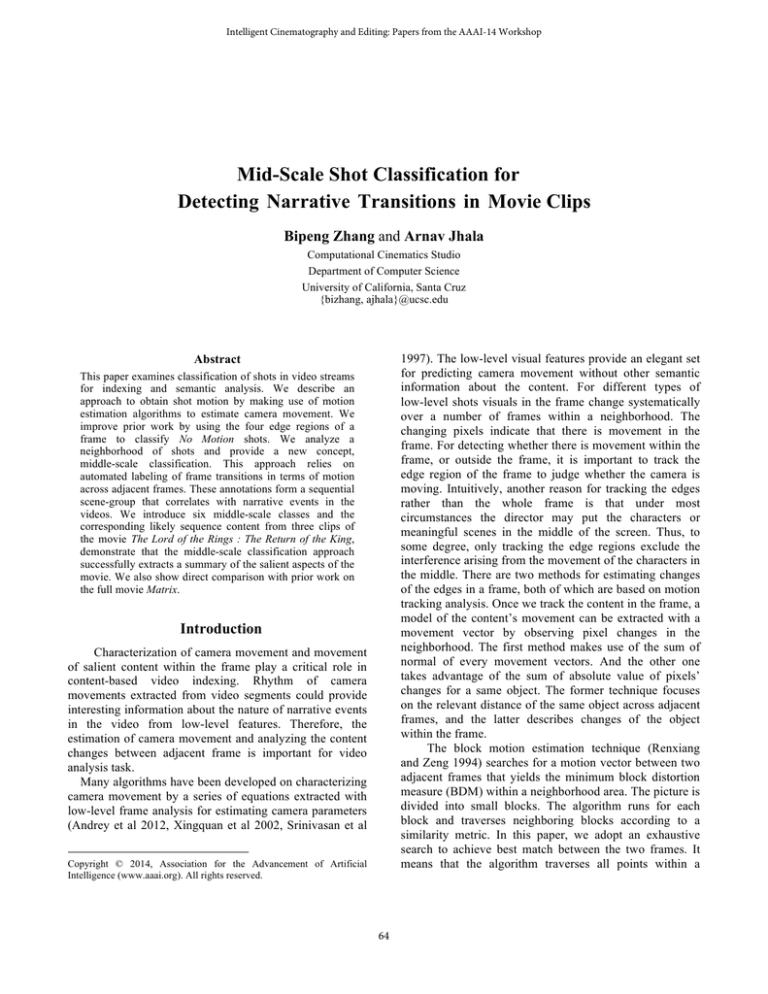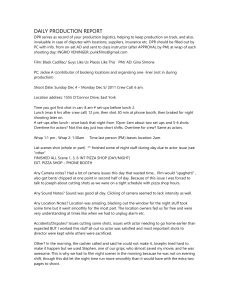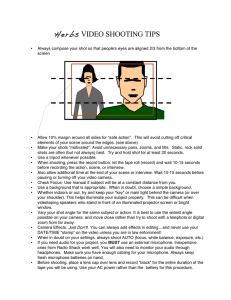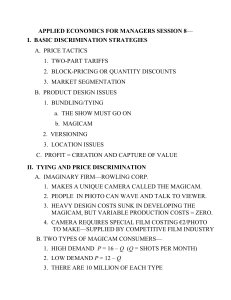Mid-Scale Shot Classification for Detecting Narrative Transitions in Movie Clips Bipeng Zhang
advertisement

Intelligent Cinematography and Editing: Papers from the AAAI-14 Workshop
Mid-Scale Shot Classification for
Detecting Narrative Transitions in Movie Clips
Bipeng Zhang and Arnav Jhala
Computational Cinematics Studio
Department of Computer Science
University of California, Santa Cruz
{bizhang, ajhala}@ucsc.edu
1997). The low-level visual features provide an elegant set
for predicting camera movement without other semantic
information about the content. For different types of
low-level shots visuals in the frame change systematically
over a number of frames within a neighborhood. The
changing pixels indicate that there is movement in the
frame. For detecting whether there is movement within the
frame, or outside the frame, it is important to track the
edge region of the frame to judge whether the camera is
moving. Intuitively, another reason for tracking the edges
rather than the whole frame is that under most
circumstances the director may put the characters or
meaningful scenes in the middle of the screen. Thus, to
some degree, only tracking the edge regions exclude the
interference arising from the movement of the characters in
the middle. There are two methods for estimating changes
of the edges in a frame, both of which are based on motion
tracking analysis. Once we track the content in the frame, a
model of the content’s movement can be extracted with a
movement vector by observing pixel changes in the
neighborhood. The first method makes use of the sum of
normal of every movement vectors. And the other one
takes advantage of the sum of absolute value of pixels’
changes for a same object. The former technique focuses
on the relevant distance of the same object across adjacent
frames, and the latter describes changes of the object
within the frame.
The block motion estimation technique (Renxiang
and Zeng 1994) searches for a motion vector between two
adjacent frames that yields the minimum block distortion
measure (BDM) within a neighborhood area. The picture is
divided into small blocks. The algorithm runs for each
block and traverses neighboring blocks according to a
similarity metric. In this paper, we adopt an exhaustive
search to achieve best match between the two frames. It
means that the algorithm traverses all points within a
Abstract
This paper examines classification of shots in video streams
for indexing and semantic analysis. We describe an
approach to obtain shot motion by making use of motion
estimation algorithms to estimate camera movement. We
improve prior work by using the four edge regions of a
frame to classify No Motion shots. We analyze a
neighborhood of shots and provide a new concept,
middle-scale classification. This approach relies on
automated labeling of frame transitions in terms of motion
across adjacent frames. These annotations form a sequential
scene-group that correlates with narrative events in the
videos. We introduce six middle-scale classes and the
corresponding likely sequence content from three clips of
the movie The Lord of the Rings : The Return of the King,
demonstrate that the middle-scale classification approach
successfully extracts a summary of the salient aspects of the
movie. We also show direct comparison with prior work on
the full movie Matrix.
Introduction
Characterization of camera movement and movement
of salient content within the frame play a critical role in
content-based video indexing. Rhythm of camera
movements extracted from video segments could provide
interesting information about the nature of narrative events
in the video from low-level features. Therefore, the
estimation of camera movement and analyzing the content
changes between adjacent frame is important for video
analysis task.
Many algorithms have been developed on characterizing
camera movement by a series of equations extracted with
low-level frame analysis for estimating camera parameters
(Andrey et al 2012, Xingquan et al 2002, Srinivasan et al
Copyright © 2014, Association for the Advancement of Artificial
Intelligence (www.aaai.org). All rights reserved.
64
certain scope. Although the method needs more
computation, for this work, we focus on accuracy of results
rather than performance bottlenecks of the algorithm.
Adams et al (2001), followed this approach and
introduced three shot motion classes: No motion, Fluid and
Staccato. They demonstrated that these are useful in
classification of shots in movies (Adams et al 2001). They
defined a parameter m which denotes shot motion. First,
based on a given threshold of the average m in the whole
shot, they labeled shots with No Motion and Motion. Then
each motion shot was classified as Fluid or Staccato by a
threshold of the average of the derivative of m for the
whole shot length. They chose three movies, Lethal
Weapon2, Color Purple and Titanic, to test this method.
Finally, they provided seven classes to distinguish a group
of shots and presented the likely sequence content and
corresponding causes of them from film grammar.
In this paper, we focus our analysis on The Lord of
the Rings: The Return of the King, and analyze several
clips from the movie. Choice of this movie is justified due
to the variety of visual variations and narrative content. In
terms of pacing, the movie has faster action segments as
well as slower dramatic dialogue segments. It provides us
with rich content including long dialogue, battle scene,
smaller skirmishes, variety of lenses and transitions.
First, we describe our approach for achieving motion
parameter m and provide a method to distinguish
immediate transitions during a clip. Then we classify shots
from the movie and introduce our enhancement,
Middle-Scale classification, by analyzing three clips of the
movie. Finally, we provide six middle-scale classes and
show their likely sequence content in the table.
1 M N
∑∑ f k (m, n) − f k −1 (m + i0 , n + j0 )
MN m =1 n =1
where f k −1 , f k refer to the blocks in previous frame and
current frame that are to be compared.
Once we find such (i0,j0), it means that point A(i,j) in
the current frame and point B(i+i0,j+ j0) in the previous
frame are the same point. Then we can also define the pixel
changes of the same points in the adjacent frames by
DIFF (i, j ) = f k (i, j ) − f k −1 (i + i0 , j + j0 )
where i0 and j0 may change for different blocks.
The DIFF defines changes with regardless of the
distance between such two points. For each frame, we also
calculate SDIFF, the sum of absolute value of each element
in DIFF. The greater SDIFF means that there is a more
obvious change for the same object in a pair of frames. The
SDIFF(N), where N is the number of a frame in the whole
shot, can define such trend in the whole shot. If we want to
evaluate the camera movement, we should define a
coefficient SNV which is the sum of normal of the vectors
uuuv
like AB .
M N uuuu
r
SNV = ∑∑ ( AB ( dx 2 + dy 2 )1 2 )
m =1 n =1
uuuur
where AB refers to the distance of the same blocks in
MAD(i0 , j0 ) =
the two adjacent frames.
The greater SNV means the object or the camera
move faster. For the four edge regions (Figure 1(b)), we
calculate four SNVi(i=1,2,3,4). The camera will be
considered moving only if the SNVi (i=1,2,3,4) satisfy the
corresponding threshold Ti(i=1,2,3,4). Like DIFF, we
define the sum of normal of vectors in edge regions by
SSNV, which is the sum of SNVi (i=1,2,3,4) with
subtracting the value of four corner regions. Also, the
SSNV(N) can define the camera movement in the whole
shot.
Otherwise, we take advantages of the derivative of
SDIFF(N) and SSNV(N) to measure the rate of content
change and camera movement in edge regions. We choose
the average of SSNV(N) to judge whether there is camera
movement in the frame and the derivative of SSNV(N) can
help to judge whether the shot is Fluid or Staccato.
Background and Features
Motion tracking
(a)
Detecting cuts with the derivative of SDIFF(N)
(b)
Figure 1: (a) the diagram to show Full Search Method
(b) four edge regions of a frame
We use information from the derivative of SDIFF(N)
to decide whether there is a cut. First, by a given threshold,
choose pulses with greater values from the derivative of
SDIFF(N). Those big values indicate that the content in the
edge regions has changed a lot and such changes may
result from the immediate transitions. For each pulse, we
find its peak and assume that there is a transition between
the corresponding frame and the previous frame.
First, we introduce Full Search Method briefly (Figure
1(a)). The whole frame is divided into several M*N blocks.
Choose one point in a block and define searching scope dx
and dy in horizontal and vertical direction respectively. In
the whole scope, we need to find (i0,j0) to achieve
minimum Mean Absolute Deviation (MAD).
65
Experimental Results
Table 1 the results of detecting cuts in the six clips
We chose six clips with varied narrative content from
the movie. Each clip used in this analysis contained 1200
frames. Cut detection is the first step, followed by shot
classification. Finally, we show how information from
these steps can be used to analyse narrative content in a
film.
Cut Detection
We illustrate our method for cut detection with two clips.
The first clip (Figure 2(a)) shows that Gandalf and Pippin
just came to Minas Tirith and talked to Lord Denethor. In
the scene, the camera switches between the three people
often. The second clip (Figure 2(b)) shows that Faramir
defends orcs beside the river in the north of Minas Tirith.
In this clip, there is a fierce fight at first. Then the humans
are defeated and finally the leader of the orcs has a short
soliloquy.
(a)
Shot Classification
As described in Adams et al (2001), we use the same
low-level features to classify camera movement (Adams et
al 2001). In this technique the average motion parameter m
is estimated using and No Motion and Motion categories
are selected based on a threshold. Within the shots
classified in the Motion category, an average of derivative
of the motion parameter m is used to further classify Fluid
and Staccato.
In this paper, based on Brett’s principle, we propose a
improved principle with our approach to achieve motion
parameter m. The main intuition for this enhancement is to
add a preprocessing before calculating the average of shot
motion that provides more information about the next
classification stage. We consider only the four edge
regions of a frame. Regardless of particular camera moves,
the four edge regions change whenever there is camera
movement. We divide the frame into blocks and calculate
both the displacement of the block and content changes
within each block. We take advantages of the derivative of
SDIFF(N) to decide whether there is an immediate
transition in a clip. The property of function SDIFF(N) is
its range, which results in a clear distinction between the
extreme changes in shots. However, it is inappropriate for
choosing a threshold in those small values to classify
whether the camera moves or not because of its limited
range in the small values.
We classify the camera movement by following
criterion:
1) By a given small threshold T1, judge whether
objects in all four edges region of a frame changes.
2) Calculate the average of SSNV(N).
3) By a given threshold T2, decide whether the shot is
No Motion or Motion.
4) Calculate the average the derivative of SSNV(N).
5) By a given threshold T3, decide whether the shot is
Fluid or Staccato.
The first criterion helps in some circumstances that the
camera does not move however there is some object
moving in the screen. If the object is not big enough to
make changes in all four edges, then we can judge there is
no camera motion in the frame. Here we consider that the
camera may have a very small movement though it is
(b)
Figure 2: in both (a) and (b) the picture above is the
derivative of SSNV(N) and the picture below is the
derivative of SDIFF(N).The line indicates the
threshold to detect cuts.(a) the cuts detected are
labeled with circles in the clip containing dialogue
mainly (b) the wrong cut detected labeled with the
circle in the clip containing battle and dialogue
In Figure 2(a), we show transitions we detect with the
method. In Figure 2(b), there is a false positive as the
labeled cut does not exist in the second clip. The reason is
that there is a big change between the two adjacent frames
during the shot. So the labeled pulse results from the
changes of the content rather than camera movement.
Otherwise, there are some pulses which occur in the
second clip but we could not find corresponding pulses in
SSNV(N) (For each of other pulses in SDIFF(N), we
always could find a corresponding pulse in SSNV(N)). A
possible reason is that the tracking algorithm doesn’t work
well in those frames as we only try to find a best match
block within a certain scope and such block can always be
found based on the algorithm, however it may not be what
we really want. Such circumstances usually happen when
the camera moves very fast. Table 1 shows our results of
detecting the cuts in six clips.
66
stable and no object moves obviously in the frame.
Therefore, we assume a threshold T1 =Ti (i=1,2,3,4)=20 in
this paper to avoid misjudgement, which means that if one
of SNVi(i=1,2,3,4) is smaller than T1, we still consider it
as zero.
Figure 5: the derivative of SSNV(N) in the whole edge
region and the labeled circle indicates a Fluid shot
Figure 5 shows a segment of another clip and the
labeled shot indicates a camera lens from far and near,
which can be classified as Fluid. Therefore, we assume 500
as the threshold T3 to distinguish Fluid and Staccato in
criterion 5).
Table 2 shows the results of classifying all shots in the
six clips. The correct classification for No motion, Fluid
and Staccato, is 93%, 87% and 67% respectively. Both too
fast and too slow camera movement have a negative effect
on the classification.
Figure 3: the SSNV(N) in four edge regions in a frame
and the labeled circle indicates there are two regions
changing a lot and the other two ones do not.
Figure 3 shows SNVi(i=1,2,3,4) in the four edge regions
of a clip of the movie and it is an good example to
illustrate the criterion 1). This is the clip in which Faramir
defends from orcs beside the river in the north of Minas
Tirith. The labeled close-up shot shows one of soldiers
down and dying and a team of orcs are walking towards
him. The camera does not move but due to object
movement within the upper and left region, the SSNV in
the shot changes a lot. Now, due to the first criterion, This
shot is classified as No Motion. However, if we only
consider the SSNV of the whole edge region, the shot
should be classified as Motion, which is a misjudgement.
If all four SNV exceed T1, for specifying No Motion
and Motion, we calculate the average of SSNV(N) and
give the threshold T2 based on experiments.
Table 2 the results to classify all shots in six clips
The middle-scale classification and scene content
analysis
Adams provided seven classes based on the three
basic classifications, No Motion (N), Fluid (F) and
Staccato (S), to explain films’ rhythm. He distinguished
the groups of shots by the seven classes, N, F, S, NF, NS,
FS and NFS (showing in Table 3), with considering what
kind of basic classes (N,F,S) involve in the neighborhoods
of shots and the number of basic classes in the group. It
can be considered as he analyzes the rhythm of movies in a
big scale as every groups may contain hundreds of shots
based on his method in a whole movie. Such big-scale
classification ignores the order of three basic classes. In
fact, such order may convey a certain meaning from a
filmmaker and the ordered combinations can be considered
as a sort of sense-group which provides us a middle-scale
(several shots with certain meaning) between the
small-scale (only focus on one shot) and big-scale (regard
hundreds of shots as a group) to analyze rhythm of films
and index them.
Here we provide six middle-scale classes with N, S, F
Figure 4: the SSNV(N) in the whole edge region of a
group of No Motion shots with unstable background
in the clip
Figure 4 shows a clip, which is a dialogue between
Gollum and his shadow in the river. Due to the flow of the
river and the movement of the character’s head, all the
SNVi(i=1,2,3,4) are above the threshold T1. However,
truth is that the camera does not move. Thus, we need an
another threshold T2 to classify Motion and No Motion by
the average of SSNV(N) in criterion 3). From the figure (d),
we assume the threshold T2 is 60.
67
under a certain order, like NFN, SFS, FNF, SNS, NSN and
FSF(showing in Table 4). When we consider about the
middle-scale classification, for the six classes, they should
satisfy one pre-condition that the three fundamental
classes(N, S, F) in each of them should have casual
constrains between each other. In detail, we predict that the
class N shots extracted from middle-scale classes FNF and
SNS may reflect the results of the group of shots or clues
of plots afterward. The class F or S extracted from
middle-scale classes NFN and NSN will describe scenes
and atmosphere or the potential meaning of the movie. And
the middle F or S extracted from SFS and FSF indicates
the pace changes in a neighborhood of shots.
Based on the specific scene-group indicated by
middle-scale classes, we make use of them to analyze
movies’ rhythm. The basic thought is to extract every
middle-scale classes during a movie. In Figure 5, we give a
completed algorithm from cuts detection to post-processing.
In the post-processing part, mainly we give each of six
middle-scale class a weight. By such processing, we not
only can distinguish different camera motion by the
corresponding weights but also can achieve results with
different meanings by different weight strategy.
Table 3 the seven classes in Brett’s paper(Adams et al 2001)
Table 4 The six middle-scale
corresponding sequence content
Middle-scale class
SNS,FNF
NSN,NFN
SFS,FSF
classes
and
Possible sequence content
During long progressive scene or
extreme sequence, for showing the
result or clue of some movement or
plot, which helps to push story .
During dialogue or stable sequence,
for revealing characteristics of roles
or potential meaning , which riches
connotation and expression in a
movie.
During a battle or a long
progressive scene, for
showing
details or displaying magnificent
scenes, which changes the pace of
movie.
Figure 5: the completed algorithm for analyzing the
rhythm of movies
For testing our Middle-scale classification theory, we
did two experiments. Our goal for the pilot experiment was
to describe how middle-scale features help in analysis of
rhythm of movies. The second experiment directly offers
comparison with Adams et al’s results to show
improvement due to mid-scale features.
In our first experiment, we analyze the three clips
from the movie, The Lord of the Rings: The Return of the
King, with the middle-scale theory. The Figure 6 shows the
derivative of SSNV(N) of each of three clips with labeled
68
the Middle-scale classes we defined before.
example in Figure (6)(b). The F shot is from far and near to
express the Lord Denethor’s anger. And such his behavior
has direct casual connection with the two No Motion plots
next to which is Gandalf’s opinion and Denethor’s
refutation.
And the last clip in Figure (6)(c) gives us an example
of the class SFS. The shots describe that Piping and
Gandalf ride through the field on the way to Minas Tirith.
The middle F shot slows down the pace of the group of
shots. Both of S shots convey a sense of hurry, however,
the director inserts a F shot into them, which makes the
group of shots distinguish from some extreme sequence
like SSS.
In the second experiment, we applied our method to
the whole movie, The Matrix. After the detection, we use
1,2,3 referring to three fundamental classes and use other
six numbers to indicate middle-scale classes. The bigger
number means more fierce camera motion in
corresponding shots. For comparing with the result in
Adams’s paper, we use four red circles to show the similar
parts and one rectangle to show mainly different part in
both pictures in Figure 7. From macroscopic point, we
could achieve similar results to prior work.
(a)
(b)
(c)
Figure 6: (a) the clip contains battle and dialogue;
(b) the clip contains dialogue and close-up lens; (c)
the clip contains long progressive scenes
The clip in Figure 6(a) describes the scene where
humans are defeated in a battle againts orcs. The
discontinuous shots in this segment express fear and
helplessness against a strong enemy. The No Motion shots
here mainly exert the function of pushing the story. The
first labeled group of shots is classified as SNS. During the
series of shots, there is a No Motion shot describing a
human solider down, which paves the way for the later plot
that the solider will be killed. The class SNS has particular
characteristics for filming such a sequence. The N shot is
important under this circumstance as it embodies some
intention of the filmmaker.
For the class NSN, the important part is the S. The S
between two No Motion plots should reveal some
intentions of the director, which may have causal
relationship with the two N shots next to the class S. In this
neighborhood of shots, the first N shot describes a team of
orcs have come to an injured human solider. The second
close-up N shot shows the hands of the orc and a spear
next him. And in the S shot the director pans the lying
solider to express his despair and at that time the lying
solider is an epitome of the human beings. Such
scene-group is just like NFN, for which we could find an
Figure 7: the rhythm of the movie, The Matrix,
coming from Adams's method and our method
respectively. The first picture is Adams's result.
The second picture results from Middle-scale
classification theory. The four red circles in each
of pictures indicate the same parts in the movie.
The two rectangle shows mainly different results
coming from the two methods.
On further analysis, the mid-scale approach reveals
more details. For example, for the dialog part in Adams et
al’s result, they judged the neighborhood of the shots is No
Motion class. In our result, we can detect several extreme
camera motion during this episode. Also, the results arising
from our method is more consistent. Here the notion of
consistency is interpreted as the classification of similar
69
narrative segments (such as conversations) in the same
class. In the Matrix part labeled in the first picture in
Figure 7, the scenes include the traitor is wiped out and
agent Smith interrogates Morpheus, both of which are
formed by several long conversations. From the view of
content of a plot, the labeled Matrix part should be the
same as labeled Dialogue part. But with Adams’s method,
the two parts are divided into different classes.
The reason for this is that Adams et al used the
difference in shots within a sliding window to generate
different phases during a whole movie. However, in some
scenes, there may be a very long conversation, just like the
Dialogue part in The Matrix, with many cuts resulting from
the successive camera switch between each characters. The
increasing number of such cuts makes the detection not
classify the action part due to the very limited number of
action shots. Furthermore, in the Matrix part, due to
excessive camera motion, the method just counts the
number of shots with fundamental classes instead of
considering the casual constrains, which results in the
different judgment from the Dialogue part. On the other
hand, our method considers the relationship between the
adjacent shots, which means it does not focus on the
number of a certain class but detect what kinds of classes
are involved in sequential shots. Because in both Dialogue
part and Matrix part, most shots in the two parts belong to
class N and class F, based on our method, they belong to
the same genre.
For Adams’s method, although we could decrease the
width of sliding window to achieve more details in the
dialogue part, it is at the cost of accuracy on other parts.
Also, too narrow window improves recall but affects
precision.
Our method provides more flexible control to
visualize results. We can do different post-processing to
approach the goal for different purpose. For example, in
Figure 8, we assume the weight of both middle-scale class
NFN and fundamental class N as number 1 to achieve
more clear view. The reason that we can change the weight
of class NFN is that fundamental class N can be regarded
as NNN which is similar with middle-scale class NFN. For
another example, when class N and F appear alternatively,
due to the initialization of the algorithm, class FNF and
NFN can be regarded as the same class. Thus we also can
emphasis the action part in the movie by setting the weight
of middle-scale class FNF as 1 (Figure 9). Until now the
weights of classes are in accord with the average camera
motion in the shots belonging to the corresponding classes.
We also can reverse the weight to emphasis slow phase in
the movie. Therefore, based on user’s goals, we could give
different values to each of six middle-scale classes to
discover rhythm of movies from different views.
Here is another example. In Figure 10, it is the part
result of the movie, The Lord of Rings: The Return of The
King. In the movie, from the 90th minute, most scenes
describe the biggest battle in the movie, defense of the
Minas Tirith. We could see there are many extreme camera
movements in this part.
Figure 8: Showing the rhythm result of The
Matrix, which arises from different weight
strategy. In this picture, we assume the weight of
class NFN equals that of class N
Figure 9: Showing the rhythm result of The
Matrix, which arises from different weight
strategy. In this picture, the weight of class FNF,
NFN and class N are equal.
Figure 10: Showing the rhythm result of The
Lord of Rings:The Return of the King with the
same weight bewteen class NFN and class N.
Conclusion
We implemented previously proposed method of
motion tracking in video segments to classify shot types –
and subsequently narrative events. We make use of motion
tracking method to detect camera movement and achieve a
good level accuracy for detecting cuts and classifying the
shots. Further, we provide middle-scale classification
theory and introduce a new algorithm and as set of features
to analyze film rhythm. Results show that mid-scale
features perform well in detecting cuts and identifying shot
types. Further, mid-scale features improve performance of
narrative event identification proposed in prior work.
There are several limitations in our method. Here we
do not discuss evaluation of the method with respect to
70
precision and recall (F-Scores) for detecting fundamental
classes. Also, the camera motion pattern of movies are
recorded and judged by ourselves. While it is easy to
define No Motion class, we don’t have a gold standard to
compare against. Most narrative analysis is done manually
for this paper. One direction of future work may be to have
a user study to help us to decide shot types.
Another area of work is in broadening this analysis to
different types of movies in terms of length, genre,
platform, etc. There might be characteristic rhythm
features that can be learned automatically from a corpus of
annotated videos across genres. With limited extension of
this work it could be applied to indexing and
summarization of videos through identification of
interesting segments.
References
Andrey, Vavilin., and Kang-Hyun, Jo. 2012. Camera Motion
Estimation Based on Edge Structure Analysis. New Frontiers in
Graph Theory.
Xingquan, Zhu., and Xiangyan, Yue. eds. 2002. Qualitative
Camera Motion Classification for Content-Based Video Indexing.
Advances in Multimedia Information Processing.
Srinivasan, M., and Venkatesh, S, and Hosie, R. 1997.
Qualitative extraction of camera parameters. Pattern Recognition.
Renxiang, Li., and Bing, Zeng. 1994. A new three-step search
algorithm for block motion estimation. Circuits and Systems for
Video Technology, IEEE Transactions.
Brett, Adams., and Chitra, Dorai., and Svetha, Venkatesh.
Automated Film Rhythm Extraction For Scene Analysis.
2001.ICME.
71





